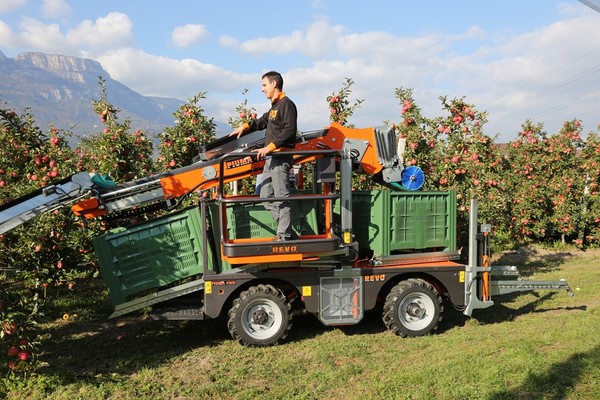
Platform for picking fruit, an "ad hoc" norm for safety
Fruit picking machines include an aerial platform used by operators at work. Special attention must be paid to safety in these conditions. The current norm of reference is the European Commission EN 280 which does not fully respond to the requirements typical of work in this agricultural environment. For this reason, the European Committee for Standardization, CEN, has approved a specific norm, the future EN 16952, arriving at the end of 2017
Machines for harvesting fruit are vehicles equipped with mobile elevated platforms which can be raised for workers to reach all parts of the tree. Other than for picking fruit, these machines can be used for pruning operations and opening and closing hail protection nets.
The most widespread type is built on a frame on which wheels and drive components are mounted, a mechinism for elevating the platform and worker(s) and fruit bins for height and lateral extension.
On this type of machine the projection to the ground in the center of the surface of the part which can be lifted is always within a machine support polygon, that is, the entire platform to be lifted is not cantilevered from the frame and complies with the new European norm being drafted.
The safety features of these machines are actually very sensitive as regards elevating personnel and materials to heights. Moreover, this is done while the machine is moving. Machines used in similar sectors such as construction work have had for some time standardized reference norms thanks to which builders are presumed to be in conformity with the EU Machinery Directive. This norm, the EN 280, does not fully meet requirements typical in the agricultural environment and this is the reason the European Standardization Committee, CEN, has approved work on a new specific norm, the future EN 16952 for enactment in 2017.
Consideration must also be given to the fact that machinery capable of elevating a work platform to heights over three meters must be examined by another agency for a Notification Procedure before reaching the market. This is stipulated by the Machinery Directive as a procedure to apply to a list of sensitive machinery categories for safety. Platforms used in farming almost always reach lower heights.
In Italy, the users of these machines must have them checked out periodically as stipulated by Decree 81/08 for safety on the job. For fruit picking machines the frequency of these controls is biennial. INAIL, the Italian Workers Accident Insurance Institute, has published instructions for the first of these periodic inspections in a document easily found on the INAIL website with a search for “fruit pickers”.
The future EN 16952 norm states specific requirements for various features of the machine. A new principal to be introduced in the norm is weight limitation: an automatic control for calculating the weight of the load on the platform and stopping its movement if an overload is detected.
The control CPU unit will also be required to act for safety for controlling the degree of the slope the machine is working on and automatically stopping it if the maximum degree stipulated by the manufacturer is exceeded as well as controlling speed so that the power-off brake is automatically activated when the transmission is in neutral. Most machines are now equipped with the power-off brake which is applied when the engine is turned off and will work in future when the transmission is shifted to neutral.
Also planned is allowing the machine to advance automatically, without requiring the driver to steer continuously. This function is needed for operations in which the driver would take part in picking fruit in the orchard and would obviously be feasible only in precise working conditions. It would be necessary for the machine to maintain a low speed of advance, about ten seconds for covering three meters, for the driver to remain close to the drivers seat and to mount a sensor which would stop the machine automatically if this distance allowed became too great.
For the physical barriers for protection against a fall from the platform, railings for example, it will be possible to angle their plane toward the vegetation to a maximum of 10° as required to allow the workers to lean out to the branches without risk and avoid having them use the intermediate current as a wrong step.
Other than automatic control for limiting the plane of the platform, there are various stability requirements related to calculations and dynamic tests which cannot be verified by the visible features of the machine but guarantee safety in use. An example is the test to be performed for coping with obstacles with the simulation of an outcrop or a hole in the ground. The size of the hole or the outcrop will be 10 cm and must be encountered first by one of the tires on the side of the machine and then by both wheels on the same axle.
Also static testing is planned for conducting them on an inclined plane to determine the physical limitations of the machine, that is, the degree of the slope at which the machine starts to overturn. The nominal degree is the maximum reported in the manual for the operator and must not exceed half the degree of the physical limit.
Finally, there are various general requirements such as controls, the hydraulic plant, protection of moving mechanical components at work and parts which heat up. These are listed in the Performance Levels of the safety functions of the automatic control systems, unique among the agricultural machinery norms, which determine the level of reliability to be expected from these controls.








